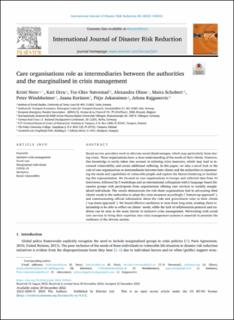| dc.contributor.author | Nero, Kristi | |
| dc.contributor.author | Orru, Kati | |
| dc.contributor.author | Nævestad, Tor-Olav | |
| dc.contributor.author | Olson, Alexandra | |
| dc.contributor.author | Schobert, Maira | |
| dc.contributor.author | Windsheimer, Peter | |
| dc.contributor.author | Keränen, Jaana | |
| dc.contributor.author | Jukarainen, Pirjo | |
| dc.contributor.author | Kajganovic, Jelena | |
| dc.date.accessioned | 2023-06-13T12:10:39Z | |
| dc.date.available | 2023-06-13T12:10:39Z | |
| dc.date.created | 2023-01-05T12:42:02Z | |
| dc.date.issued | 2023-02-15 | |
| dc.identifier.citation | International Journal of Disaster Risk Reduction. 2022, 86 (15 February 2023), 1-23. | en_US |
| dc.identifier.issn | 2212-4209 | |
| dc.identifier.uri | https://hdl.handle.net/11250/3071154 | |
| dc.description | Published by Elsevier Ltd. This is an open access article under the CC BY-NC license (http://creativecommons.org/licenses/by-nc/4.0/). | en_US |
| dc.description.abstract | Social service providers work to alleviate social disadvantages, which may particularly loom during crises. These organisations have a close understanding of the needs of their clients. However, this knowledge is rarely taken into account in tailoring crisis measures, which may lead to increased vulnerability and create additional suffering. In this paper, we take a novel look at the role of care organisations as intermediaries between their clients and the authorities in representing the needs and capabilities of vulnerable people and explore the factors hindering or facilitating this representation. We focused on care organisations in Europe and collected data from 32 interviews, followed by 5 workshops and an international colloquium with 6 language-based discussion groups with participants from organisations offering care services to socially marginalised individuals. The results demonstrate the role these organisations had in advocating their clients' needs to the authorities to adapt the crisis measures accordingly (“bottom-up approach”), and communicating official information about the risks and government rules to their clients (“top-down approach”). We found effective mediation to stem from long-term, trusting client relationship to be able to reflect on clients’ needs, while the lack of collaboration protocol and tradition can be seen as the main barrier to inclusive crisis management. Networking with social care services to bring their expertise into crisis management systems is essential to promote the resilience of the diverse society. | en_US |
| dc.description.abstract | Care organisations role as intermediaries between the authorities and the marginalised in crisis management | en_US |
| dc.language.iso | eng | en_US |
| dc.publisher | Elsevier | en_US |
| dc.title | Care organisations role as intermediaries between the authorities and the marginalised in crisis management | en_US |
| dc.title.alternative | Care organisations role as intermediaries between the authorities and the marginalised in crisis management | en_US |
| dc.type | Journal article | en_US |
| dc.type | Peer reviewed | en_US |
| dc.rights.holder | © 2023 The Authors. | en_US |
| dc.source.articlenumber | 103516 | en_US |
| dc.description.version | publishedVersion | en_US |
| cristin.ispublished | true | |
| cristin.fulltext | original | |
| cristin.qualitycode | 1 | |
| dc.identifier.doi | 10.1016/j.ijdrr.2022.103516 | |
| dc.identifier.cristin | 2101256 | |
| dc.source.journal | International Journal of Disaster Risk Reduction | en_US |
| dc.source.volume | 86 | en_US |
| dc.source.issue | 15 February 2023 | en_US |
| dc.source.pagenumber | 1-23 | en_US |
| dc.relation.project | EC/H2020/833496 | en_US |
